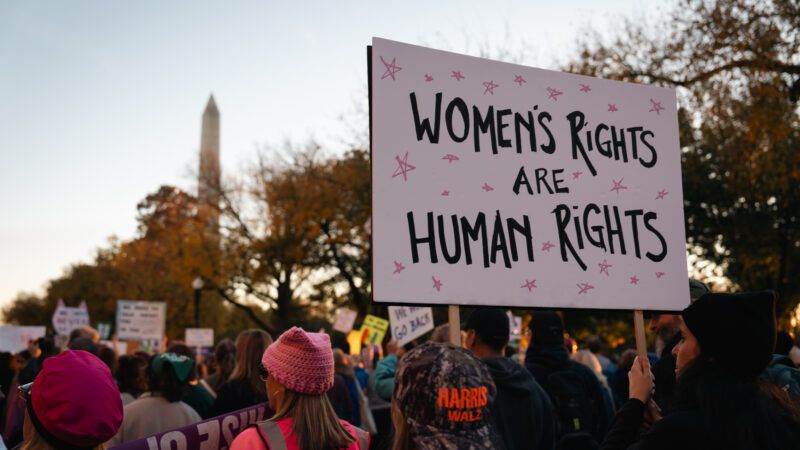Pro-Choice Abortion Initiatives Pass in Seven Out of Ten States
Most of these weren't close calls at all.

It was a pretty good night for reproductive freedom initiatives, which prevailed in seven of the ten states where they were on the ballot.
Measures meant to protect abortion access were approved by voters in Arizona, Colorado, Maryland, Missouri, Montana, Nevada, and New York. And most of these weren't close calls at all.
Still, the results are out of line with a trend seen since the Supreme Court's decision in Dobbs v. Jackson Women's Health Organization overturned Roe v. Wade in June 2022. Until yesterday, the pro-choice position prevailed in every state where abortion-related measures were on the ballot, including in red states such as Kansas, Kentucky, and Ohio.
That 2024 election pattern is broken somewhat by results in Florida, Nebraska, and South Dakota. But even in two of these states, strong support for pro-choice policies was clear.
In Florida, 57 percent of voters supported Amendment 4, an Amendment to Limit Government Interference with Abortion. Had it passed, Amendment 4—which was fought bitterly by the DeSantis administration—would have amended the Florida constitution to say that "no law shall prohibit, penalize, delay, or restrict abortion before viability or when necessary to protect the patient's health." Currently, the state only allows abortion until six weeks pregnancy.
Fifty-seven percent in favor may seem like a win, but it falls short of the 60 percent approval threshold required for constitutional amendments in Florida.
In Nebraska, 48.7 percent of voters approved the state's Right to Abortion measure, (Initiative 439), which would have amended the constitution to declare that "all persons shall have a fundamental right to abortion until fetal viability." It was a close call, yet ultimately a loss. But a competing measure—Initiative 434—passed 55.3 percent to 44.7 percent and, while not as supportive of legal abortion as 439, it's also something of a pro-choice bill. Initiative 434 still allows for first trimester abortions but prohibits second and third trimester abortion unless "necessitated by a medical emergency or when the pregnancy results from sexual assault or incest."
Only in South Dakota—where it's currently criminal to perform an abortion or prescribe abortion medication unless a pregnant woman's life is at risk—did a reproductive freedom initiative truly flop. Voters rejected Amendment G—a citizen-led initiative to enshrine abortion rights in the state's constitution—by almost 20 percentage points (with 87 percent of votes counted).

Meanwhile, reproductive freedom initiatives saw decisive victories in the remaining seven states that considered them, including in some states that currently have restrictive abortion bans.
In Arizona, voters approved Proposition 139, a measure that enshrines a "fundamental right" to abortion until fetal viability in the state's constitution. Abortion is currently legal in Arizona only until 15 weeks pregnancy. Voters rejected this status quo, with about 62 percent voting for Proposition 139 with 60 percent of votes tallied.
In Missouri, where abortion is currently illegal except in medical emergencies, voters approved Amendment 3, a constitutional amendment declaring that "the Government shall not deny or infringe upon a person's fundamental right to reproductive freedom, which is the right to make and carry out decisions about all matters relating to reproductive health care, including but not limited to prenatal care, childbirth, postpartum care, birth control, abortion care, miscarriage care, and respectful birthing conditions." The measure goes on to stipulate that regulations after fetal viability are permitted, so long as they're "achieved by the least restrictive means" and don't "deny, interfere with, delay, or otherwise restrict an abortion that in the good faith judgment of a treating health care professional is needed to protect the life or physical or mental health of the pregnant person."
Voters in several states where abortion is currently legal up to at least fetal viability also opted to enshrine abortion rights in their state constitutions.
In Maryland, where abortion is currently legal until fetal viability, voters overwhelmingly approved Question 1, also known as the Right to Reproductive Freedom Amendment. The tally was about 74 percent for and just 26 percent with three-quarters of votes counted. Initiated by state lawmakers, the measure enshrines in the Maryland constitution "an individual's fundamental right to an individual's own reproductive liberty." Specifically, the amendment says "the State may not, directly or indirectly, deny, burden, or abridge the right [to an abortion] unless justified by a compelling State interest achieved by the least restrictive means."
In Montana, where abortion is currently legal until fetal viability, voters approved The Right to Abortion Initiative, also known as CI-128. The measure will amend the state constitution to say "there is a right to make and carry out decisions about one's own pregnancy, including the right to abortion," and "this right shall not be denied or burdened unless justified by a compelling government interest achieved by the least restrictive means." It goes on to say that the state "may regulate the provision of abortion care after fetal viability provided that in no circumstance shall the government deny or burden access to an abortion that, in the good faith judgment of a treating health care professional, is medically indicated to protect the life or health of the pregnant patient." With 87 percent of Montana's votes counted, it was winning 57.4 percent to 42.6 percent.
In Nevada, where abortion is now legal until 24 weeks pregnancy, voters approved Question 6, putting the state on the path to guaranteeing a "fundamental right" to abortion until fetal viability in the Nevada constitution. The measure states that the right to an abortion "shall not be denied, burdened, or infringed upon unless justified by a compelling state interest that is achieved by the least restrictive means." With 84 percent of Nevada votes counted, it was up 63.3 percent to 36.7 percent. However, it must pass again in 2026 to be enacted.
In Colorado, where abortion is currently legal throughout pregnancy, voters passed Amendment 79, a citizen-led initiative also known as the Colorado Right to Abortion and Health Insurance Coverage Initiative. The measure repeals a 1984 amendment prohibiting the use of public funds for abortion and creates a new constitutional amendment stating that "the right to abortion is hereby recognized. Government shall not deny, impede, or discriminate against the exercise of that right, including prohibiting health insurance coverage for abortion."
And New Yorkers opted by a large margin to adopt Question 1, an amendment that adds discrimination protections to the state constitution, which currently bars discrimination based on "race, color, creed, or religion." The amendments adds to this "ethnicity, national origin, age, disability, or sex, including sexual orientation, gender identity, gender expression, pregnancy, pregnancy outcomes, and reproductive healthcare and autonomy."
Some of these results are no surprise. New York, Colorado, and Maryland are firmly blue states. But reproductive freedom wins didn't neatly match up to red/blue divides. Trump won Florida, Missouri, and Montana and is leading in Arizona and Nevada (though AP hasn't called these races yet), yet a majority of voters in these states, too, opted to support legal abortion.
These results suggest that no matter which politicians people choose, the right to choose is still broadly popular around the country.




Show Comments (40)